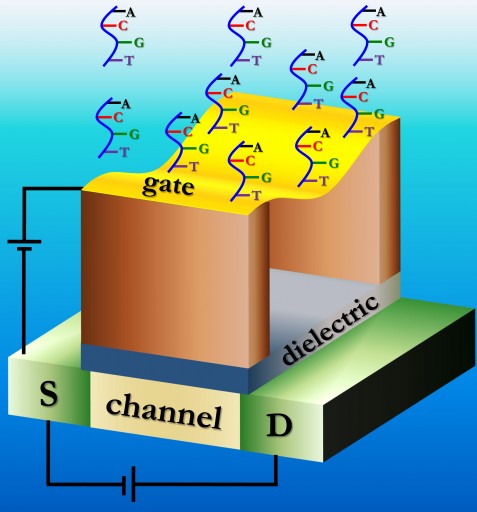Ultrasensitive biosensor promising for medical diagnostics
May 16, 2012
An ultrasensitive biosensor that could allow for early detection of cancer and for personalized medicine tailored to the specific biochemistry of individual patients has been developed by Purdue University researchers.
The Flexure-FET biosensor combines a mechanical sensor, which identifies a biomolecule based on its mass or size, with an electrical sensor that identifies molecules based on their electrical charge.
The new sensor detects both charged and uncharged biomolecules, allowing a broader range of applications than either type of sensor alone.
The sensor makes it possible to detect small quantities of DNA fragments and proteins deformed by cancer long before the disease is visible through imaging or other methods, said Muhammad A. Alam, a Purdue University professor of electrical and computer engineering.
The sensor’s mechanical part is a vibrating cantilever, a sliver of silicon that resembles a tiny diving board. Located under the cantilever is a transistor, which is the sensor’s electrical part.
In other mechanical biosensors, a laser measures the vibrating frequency or deflection of the cantilever, which changes depending on what type of biomolecule lands on the cantilever. Instead of using a laser, the new sensor uses the transistor to measure the vibration or deflection.
The sensor maximizes sensitivity by biasing both the cantilever and transistor. The cantilever is biased using an electric field to pull it downward as though with an invisible string and the transistor is biased by applying a voltage.
“You can make the device sensitive to almost any molecule as long as you configure the sensor properly,” Alam said.
A key innovation is the elimination of a component called a “reference electrode,” which is required for conventional electrical biosensors but cannot be miniaturized, limiting practical applications. This makes it feasible for low-cost, point-of-care applications in doctors’ offices, Alam said.
Ref.: Ankit Jain, P. R. Nair, M. A. Alam, The Flexure-FET Biosensor: How to Break the Fundamental Sensitivity Limits of Nanobiosensors using Nonlinear Electromechanical Coupling, Proceedings of the National Academy of Sciences, 2012, in press
